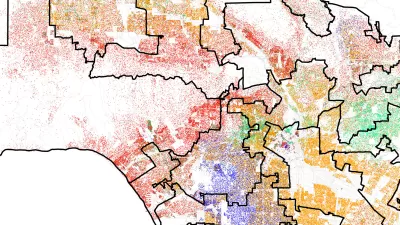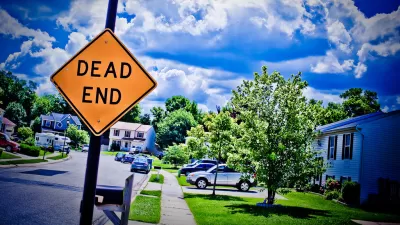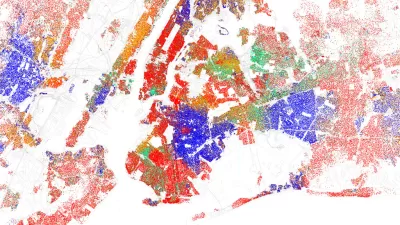2010 Census

Diverse on Paper, Segregated in Reality
Many places are statistically diverse, but their inhabits can be worlds apart. A local perspective (and finer data) is needed to fully appreciate how different races and classes inhabit a neighborhood.

The Changing Shape of American Cities
A newly released report shows the demographic transformation of American cities spatially from 1990 to 2012 by charting their neighborhoods based on distance to the center of the city.

More Evidence for the 'New Donut' Model of Metropolitan Areas
Spatial analysis of income and education over time in U.S cities provides further evidence for the “New Donut” theory of the city. Wealthier and more educated residents are more likely to move to the urban core or exurbs than to inner-ring suburbs.

Are We Being Fooled Again By Census Bureau Misestimates?
The Census Bureau's questionable methodology for estimating municipal population growth has resulted in counter-intuitive and often outrageous numbers, warns Aaron M. Renn.
The Bright Side of California's Growth Slowdown
According to a just-released report from USC, CA's population, currently 37.5 million, will reach 50 million in the year 2046, a full 14 years later than the 2007 Dept. of Finance projection, due to the major growth slowdown shown in 2010 Census.
No Car? No Problem in Washington, D.C.
Drawing on 2010 Census data, the Coalition for Smarter Growth highlights the prevalence of alternative transportation in the nation's capital.
The Second Coming of Marked-Down Detroit
The 2010 Census reveals that Detroit's population is approaching the 1910's level. Of the City's 714,000 residents, 83% are black and nearly 40% live in poverty. With virtually every statistic going against its favor, can Motown make a comeback?
All That Glitters in Provincetown, Mass.
With same-sex couples coming out in record-breaking number on the 2010 Census, West Hollywood and San Francisco are dethroned as the meccas of gay cities - at least for those who chose to settle down.
Minorities Transform Metro Areas, Inch Closer to Majority
Minorities comprise in 2010 more than half the population in 22 of the largest metro areas in and 98 percent population growth in large metro areas from 2000 to 2010, a recent report by The Brookings Institute shows.
Minorities Move Up Social Ladder, Stay in Poorer Neighborhoods
A new study shows how even as minorities move up the social ladder, they tend to live in poorer neighborhoods, reports Joanna Lin for California Watch.
McMansion No More
2010 Census offers telling evidence of America's shifting demographics. Diana Olick of CNBC contextualizes the new U.S. household data in terms of real estate development.
Federal Funds on the Line as Cities Challenge Census Results
The U.S. Conference of Mayors expect the number of challenges to be higher than the 1,200 challenges filed for the 2000 Census because regions claimed to have received low population counts.
Graying of the Suburban Image
The 2010 Census showed that the baby-boom generation led to the growth of older populations settling in suburbs, which is causing local governments to rethink whom their services should cater to.
The Fastest-Growing City in the U.S.
Would you believe its Olive Branch, Mississippi? Since 1990, the Memphis suburb has grown an astonishing 838 percent.
Detroit Census Confirms Unprecedented Desertion
Detroit's population plunged by 25% over the last decade, according to census figures - the largest decline of any major city in American history.
Dwindling Small Towns Fight Back
Census data shows that Lacrosse, WA (pop. 315) and other small, rural towns are getting smaller. Some blame the Conservation Reserve Program. But Lacrosse and many others aren't going quietly - they're fighting to hang on.
Census 2010: the early returns
Census data is already in for a couple of dozen states, and already blogs are starting to speculate about their lessons for American cities. Some commentators look at the continued decline of Rust Belt cities like Chicago and St. Louis, and suggest that suburban sprawl continues (and will forever continue) unabated. But reality is not quite so simple.
St. Louis Loses People to Exurbs
St. Louis is reeling from the news that it lost 29,000 residents, or 8%, of its population since 2000. Bi-annual population estimates had led many to believe the city had finally turned a corner. Meanwhile, exurban counties posted 30+ percent growth.
Unusual Findings from Census 2010
Laurent Belsie takes a first look at some unexpected results from Tuesday's data release.
New Study Reveals Poverty Growing Twice as Fast in Suburbs
A Brookings Study of census data finds that since 2000, the number of poor people in the suburbs jumped by 37.4% to 13 million and "the growth rate of suburban poverty is more than double that of cities."
Pagination
Urban Design for Planners 1: Software Tools
This six-course series explores essential urban design concepts using open source software and equips planners with the tools they need to participate fully in the urban design process.
Planning for Universal Design
Learn the tools for implementing Universal Design in planning regulations.
City of Santa Clarita
Ascent Environmental
Institute for Housing and Urban Development Studies (IHS)
City of Grandview
Harvard GSD Executive Education
Toledo-Lucas County Plan Commissions
Salt Lake City
NYU Wagner Graduate School of Public Service


































